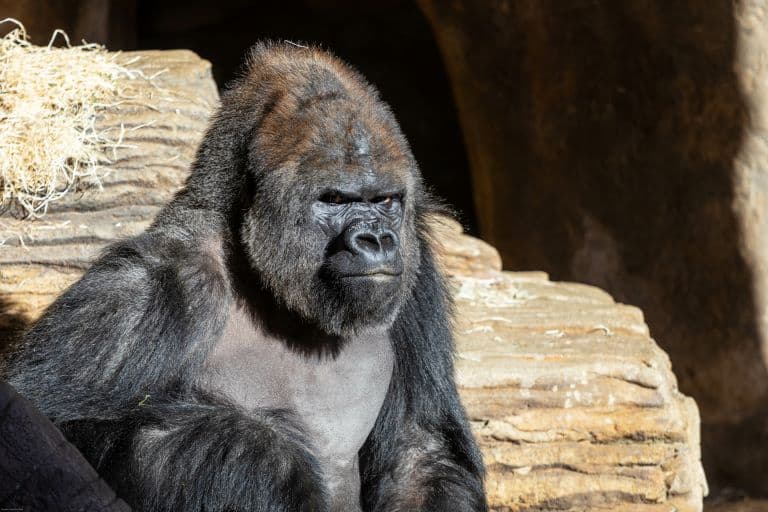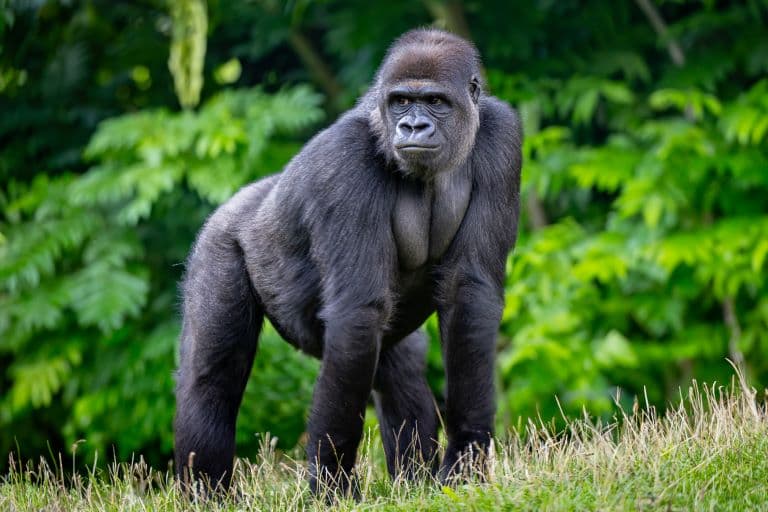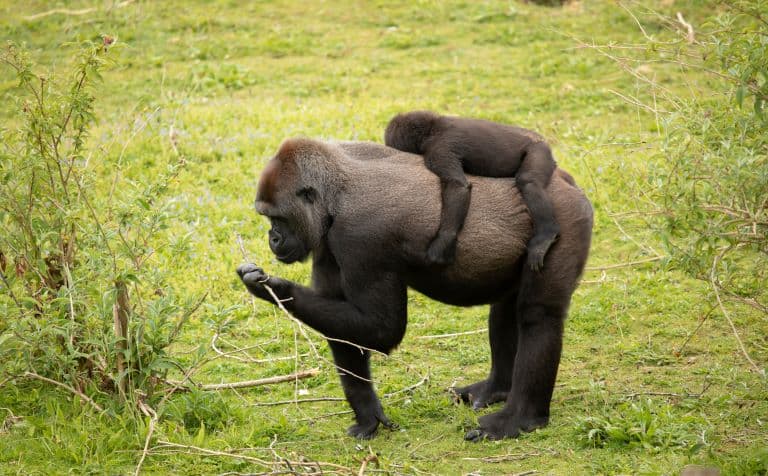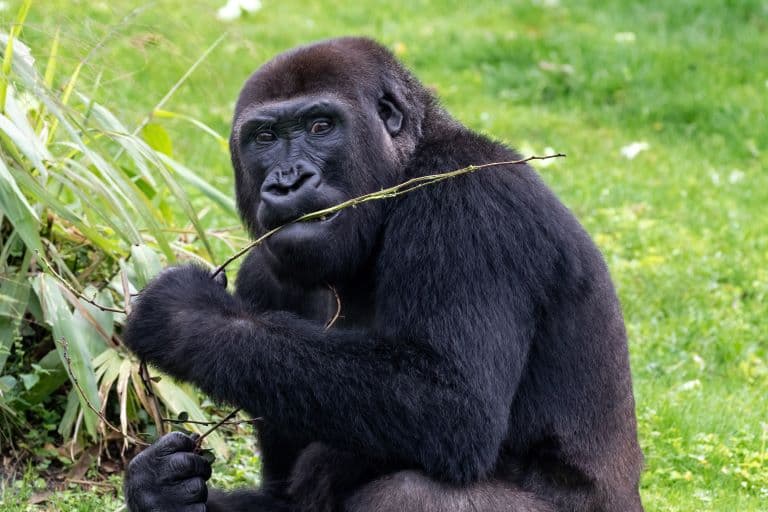Western Lowland Gorilla Profile
The heaviest and most powerful ape on Earth is also one of the most peaceful.
A renowned vegetarian, this massive, intelligent cousin of humans lives quietly in the rainforests of Central and West Africa; a habitat that is rapidly shrinking.
As a result, these gentle giants rapidly shrink with it, and the Western Lowland Gorilla, while not as devastatingly scarce as their mountain cousins, are still in dire need of protection.

Western Lowland Gorilla Facts Overview
| Habitat: | Lowland tropical forest |
| Location: | Central and West Africa |
| Lifespan: | 35 in the wild |
| Size: | 1.8m tall |
| Weight: | Up to 226kg (500lb) |
| Colour: | Black, sometimes grey legs and back |
| Diet: | Roots, leaves, shoots, fruit |
| Predators: | Humans |
| Top Speed: | Possibly 32 kmph (20mph) |
| No. of Species: | 1 |
| Conservation Status: | Critically Endangered |
Slightly smaller than their Eastern cousins, this subspecies lacks nothing in all other capacities. The Western Lowland Gorilla is a powerful, intelligent animal with a complex society and an ability to evade our understanding.
They’re relatively diplomatic, move around a lot, and use their incredible smarts to survive in a community that we are still discovering the quirks of today.
While their numbers are still in the hundreds of thousands, they’re in rapid decline and are considered critically endangered due to poaching, habitat loss, and disease.
Interesting Western Lowland Gorilla Facts
1. They’re well led
Silverbacks are well known for being the ultimate giants of the ape world, yet many humans who associate with this perceived brute have the concept of an Alpha male all wrong.
Gorilla troops are led by a single Alpha male, but this is not a matter of brutishness. The Alpha’s size is for the protection of the group, not for bullying, and the role is one that is respected by the rest, rather than simply feared.
There’s a dominance hierarchy in both males and females, with the Silverback at the top, and he mediates disputes, looks after and plays with babies, and generally acts like an all-round swell guy.
The silverback mates with all the receptive female gorillas, but he’s not necessarily the only one to do so, and while infanticide does occur when a silverback death results in a new male entering, in a stable group, there can be offspring of multiple males growing up together. 1

2. Females are wise to this
The death of a long-tenured silverback can create huge turmoil in the gorilla world, as it often does in chimp society. Power struggles among powerful apes can get very bloody, and even among the relatively peaceful gorilla communities, deaths are not uncommon.
Infanticide rates are high in Western lowland gorilla communities during these struggles, and so females in a group with an ageing male may have to strategically vacate the premises.
In one study group, females were spotted leaving the group of an old male for one with a younger silverback, during the brief window after they had weaned their young, but before they were receptive to conceive the next.
This sort of clever foresight is undeniable evidence of an intelligent and highly social animal and one that we still don’t know nearly enough about. 2

3. They’re smart!
There are some very high-profile demonstrations of gorilla intelligence. In captivity, they’ve been taught by keepers to both use and understand sign language, and one example of a strangely nipple-obsessed captive gorilla named Koko was said to have understood over 1000 signs and could form simple sentences.
In the wild, they’ve been witnessed forming tools for various tasks, and are thought to be at least as smart as young human children. 3
4. They’re harder to study
Mountain gorillas are the species that gets the most attention and for a number of good reasons. Firstly, they’ve only recently recovered from population figures as low as three digits.
Secondly, they tend to stay put, and occupy smaller ranges, which makes tracking and monitoring them a lot easier for the researchers involved.
Western Lowland gorillas, on the other hand, occupy vast ranges and move around them quite a bit. There are also a lot more of them, both in total number (possibly upwards of 300,000), and family groups, and they move between groups often, making individuals hard to keep track of too.
On top of all this, they live in some very unstable places. DRC is home to around 100,000 of them, and besides being absolutely enormous, it’s also a dangerous place to conduct research.
So, there are a lot of factors that make both estimating WLG populations and then monitoring them quite tricky. And that’s a shame because they’re under threat from many angles. 4
5. Threats
By the 1990s, the previously undisturbed swathes of the forest in which these gorillas lived had high densities of gorillas and low densities of humans.
This is a much better deal for the gorilla, as demonstrated by the fact that people soon arrived and chopped down most of the trees, cut logging roads through the rest, and introduced a bushmeat hunting trade in which gorillas were killed for food.
Mining and logging industries create a demand for this bushmeat, and it’s the primary threat to gorilla populations in an increasingly devastated natural environment. Almost all non-protected forest has either now been removed, or allocated for logging.
But humans bring more than physical destruction with them.

6. We can also make them sick
Disease is the second most significant danger to the WLGs, and ebola is a big part of that. Outbreaks can accelerate through gorilla communities and in at least one case killed 95% of those affected.
Humans themselves, and their livestock both threaten to contaminate the gorillas with diseases that are common among the species, and have already been responsible for numerous ‘great ape die-offs’.
Recovery from these catastrophic events can take a decade to begin and over a hundred years to complete, and that’s only if all conditions of protection are met. Outside of protected areas, the damage can be permanent.
7. Palm oil’s legacy spreads to Gorilla habitats
A lot of the habitat loss gorillas face comes from an increasing focus on palm oil production. The majority of oil palm is grown in Malaysia and Indonesia, but as these countries reach their carrying capacity, African nations are stepping up to meet growing demand.
The soil conditions, rainfall and temperatures ideal for gorilla habitat are more or less the same as those the oil palm love, so suddenly there’s another powerful competition for land.
These developments call for serious attention to gorilla conservation in the form of land planning and government/stakeholder cooperation to ensure that there’s enough protected land for gorillas and palm oil to coincide peacefully.
Conservationists are concerned that within just a few decades, the majority of WLG habitat could be destroyed.
Western Lowland Gorilla Fact-File Summary
Scientific Classification
| Kingdom: | Animalia |
| Phylum: | Chordata |
| Class: | Mammalia |
| Order: | Primates |
| Family: | Hominidae |
| Genus: | Gorilla |
| Species: | Gorilla |
| Subspecies: | Gorilla |
Fact Sources & References
- (2019), “Episode Two: Male hierarchy and a gorilla group’s success”, Gorilla Fund.
- Marie L. Manguette (2020), “Infant survival in western lowland gorillas after voluntary dispersal by pregnant females”, Springer Link.
- DOUGLAS MAIN (2020), “Why Koko the Gorilla Mattered”, National Geographic.
- “Western Gorilla”, IUCN Red List.
